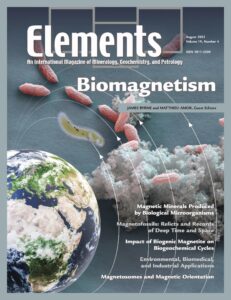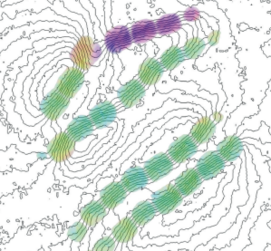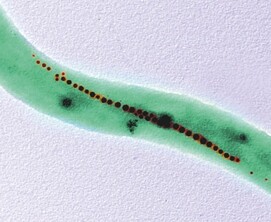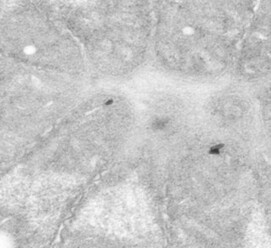Biomagnetism
James Byrne and Matthieu Amor – Guest Editors
Table of Contents
In this thematic issue of Elements, we look into biomagnetism and the production of magnetic minerals by microorganisms. In popular culture, this may have supernatural connotations; however, in reality, there are many microscopic biological organisms possessing magnetic behaviour owing to their formation of magnetic nanoparticles (MNP) such as magnetite (Fe3O4), maghemite (γ-Fe2O3), and greigite (Fe3S4). We look broadly at the relationship between biogenic MNP formation and biomagnetism: focusing on the mechanisms responsible for these minerals by bacteria; seeking to address whether MNP hold clues to the evolution of life on Earth, and potentially beyond; investigating the contribution of biomagnetism to the biogeochemical cycling of iron; considering the potential application of MNP for industrial remediation; and probing the presence of MNP in multicellular prokaryotes and eukaryotic organisms.
- Biomagnetism: Insights into Magnetic Minerals Produced by Biological Microorganisms
- Magnetofossils: Relicts and Records of Deep Time and Space
- Impact of Biogenic Magnetite Formation and Transformation on Biogeochemical Cycles
- Environmental, Biomedical, and Industrial Applications of Biogenic Magnetite Nanoparticles
- Magnetosomes and Magnetic Orientation in Multicellular Prokaryotes and Eukaryotes
LARGE IGNEOUS PROVINCES: VERSATILE DRIVERS OF GLOBAL CHANGE
Guest Editors: Frances M. Deegan (Uppsala University, Sweden), Sara Callegaro (University of Oslo, Norway), Henrik H. Svensen (University of Oslo, Norway), and Joshua H.F.L. Davies (Université du Québec à Montréal, Canada)
Earth’s history is punctuated by volcanic episodes at a scale never witnessed by humans, known as large igneous provinces (LIPs). These extraordinary volcanic and tectonic events are associated with profound changes to planet Earth, including its climate and habitability. One of the major factors controlling the impacts of LIPs is the cocktail of gases emitted to the atmosphere and oceans. In this issue of Elements, we explore the versatile impacts of LIPs, from their connections to mass extinctions in aquatic and terrestrial environments to climate warming and global icehouse events. This issue also highlights our current understanding of subterranean architectures of LIPs, processes and consequences of interaction between LIP magma and surrounding crustal rocks, and advances in the timing of intrusive events.
- Driving Global Change One LIP at a Time Frances M. Deegan (Uppsala University, Sweden), Sara Callegaro (University of Oslo, Norway), Henrik H. Svensen (University of Oslo, Norway), and Joshua H.F.L. Davies (Université du Québec à Montréal, Canada)
- How Large Volcanic Eruptions Have Killed Most Life on Earth—Numerous Times Stephen E. Grasby (Geological Survey of Canada – Calgary, Canada) and David Bond (University of Hull, UK)
- Large Igneous Provinces and the Release of Thermogenic Volatiles from Sedimentary Basins Henrik H. Svensen (University of Oslo, Norway), Morgan T. Jones (University of Oslo, Norway), and Tamsin Mather (University of Oxford, UK)
- Impacts of Large-Scale Magmatism on Land Plant Ecosystems Jennifer Galloway (Geological Survey of Canada – Calgary, Canada) and Sofie Lindström (University of Copenhagen, Denmark)
- The Franklin Large Igneous Province and Initiation of Snowball Earth Francis A. Macdonald (University of California – Santa Barbara, USA) and Nicholas L. Swanson-Hysell (University of California – Berkeley, USA)
- High-Precision Geochronology of LIP Intrusions: Records of Magma–Sediment Interaction Sean P. Gaynor (Princeton University, USA), Joshua H.F.L. Davies (Université du Québec à Montréal, Canada), and Urs Schaltegger (University of Geneva, Switzerland)
- Alkaline Lakes (February 2023)
- Into the Rift: The Geology of Human Origins in Eastern Africa (April 2023)
- Olivine (June 2023)
- Biomagnetism (August 2023)
- Large Igneous Provinces: Versatile Drivers of Global Change (October 2023)
- Geometallurgy (December 2023)











